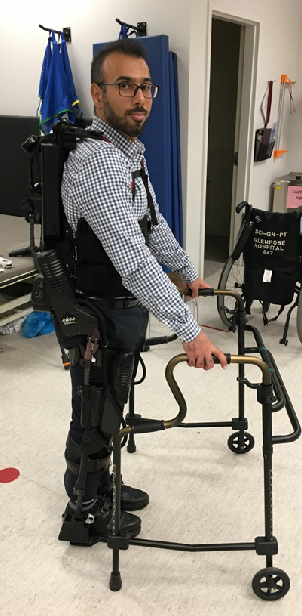
Dr. Rouhani in an assistive exoskeleton.
Mechanical Engineering Professor, Dr. Hossein Rouhani will begin the new school year with funding from the New Frontiers Research Fund, funded by Canada's Tri-Council of granting agencies (NSERC, CIHR and SSHRC). The Fund's "Exploration" stream funds projects that are "high-risk, high-reward and interdisciplinary." The success rate for attaining the funding was just 4%.
"They want us to day dream, to think the impossible," explains Rouhani. "It's a chance for us to walk into the dark and discover something."
And so that is exactly what Dr. Rouhani and his collaborators will attempt.
For his project, Dr. Rouhani has teamed up with Dr. Arash Arami at the University of Waterloo who researches mechatronics and robotics, Dr. Chester Ho, in the Department of Medicine here at the University of Alberta, as well as Dr. Kristin Musselman, at the Toronto Rehabilitation Institute. Together, the team will attempt to develop a system that can quantify neurological impairment in people with spinal cord injuries.
"We really are trying to achieve the impossible," says Rouhani. "So far, no one has been able to quantify damage to the nervous system."
Neurological impairment from spinal cord injuries is a major cause of disabilities for Canadians. Approximately 4 million adult Canadians are restricted in their daily lives as the result of some physical disability. Approximately 86,000 Canadians live with spinal cord injuries and there are 4,000 new cases every year. Many spinal cord injuries have significant ramifications on their personal lives, the lives of the families and on society at large. Patients with spinal cord injuries have the highest rate of physician visits per year and the economic burden to the health care system caused by traumatic spinal cord injuries alone is estimated to be around 2.7 billion a year.
"If you cannot walk, this affects your quality of life and your independence. An inability to walk causes economic hardship on families and burdens the healthcare system," says Rouhani.
Technologies to help people achieve mobility exist but they are underutilized because of their shortcomings.
"There are many assistive technologies available, exoskeletons and braces" explains Rouhani. "But they are not used because they are not designed to work with an individual's specific injury and their body. They are designed based on one or two people in the population and so they cannot meet the needs of a wide population."
Rouhani and his team want to design a system that will quantify and model the specific neurological impairment resulting from the spinal cord injuries of individual patients. The system can then act as an artificial nervous system for the assistive technology, allowing the assistive technology to reverse engineer solutions needed for each individual.
"It is not easy," admits Rouhani. "If it were easy someone would have done it already."
The New Frontiers Research Fund is for two-year-long projects. The timeline is ambitious, but that is exactly what the Tri-Council wanted from this set of projects. Dr. Rouhani's project will open the future for rehabilitative medicine but also for parts of Alberta's economy.
"If we develop the ability to design these smart assistive technologies, then we can create a market opportunity for Alberta."
Dr. Rouhani is still taking applications for postdoctoral fellows and graduate students to work on the project.
"It will be a unique training experience for someone because they will be trained in a variety of disciplines: engineering, the natural sciences and the health sciences," says Rouhani.
You can learn more about the project on Dr. Rouhani's website: www.ncbl.ualberta.ca